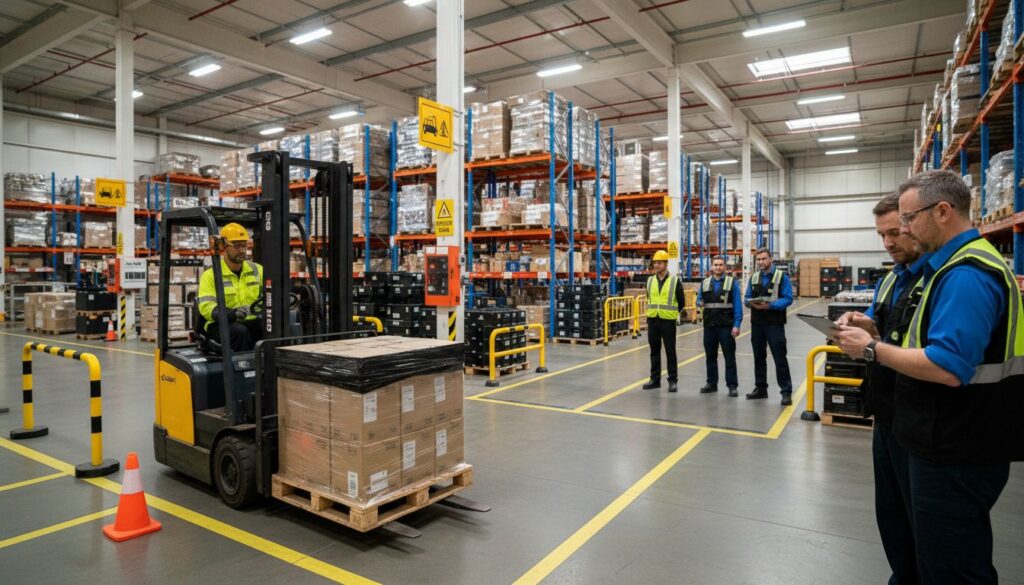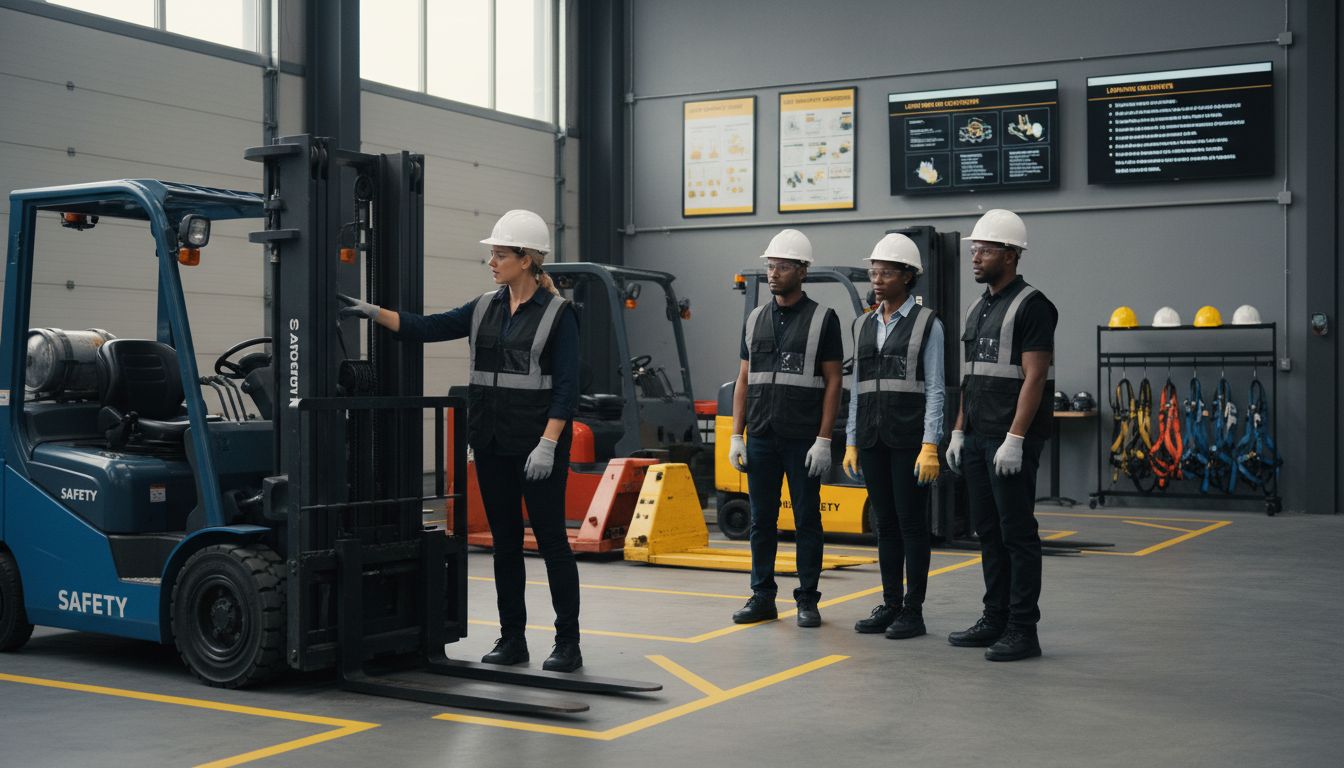
Every year, more than 100,000 forklift-related injuries are reported across american workplaces, making safety an urgent priority for companies nationwide. The high stakes of industrial operations mean that even one oversight can have serious consequences for workers and businesses alike. Understanding the rules, risks, and responsibilities tied to forklift safety empowers employers and employees to protect lives, equipment, and productivity at every stage of operations.
| Point | Details |
|---|---|
| Comprehensive Operator Training | Operators must undergo rigorous, ongoing training to meet safety and compliance standards, emphasizing both technical skills and risk management. |
| Regular Equipment Maintenance | Routine inspections and maintenance of forklifts are essential to ensure safe operation and enhance equipment reliability. |
| Proactive Safety Culture | Both employers and operators must foster a culture of safety, prioritizing continuous education and adherence to established safety protocols. |
| Clear Risk Prevention Strategies | Implementing structured hazard assessment and prevention measures can significantly reduce the likelihood of forklift-related accidents. |
Workplace safety for forklift operations is a complex and critical framework designed to protect workers and equipment from potential hazards. According to OSHA, comprehensive standards govern every aspect of powered industrial truck management, from equipment design to operational protocols. These regulations ensure that forklift operations maintain the highest possible safety standards across industrial environments.
The core of forklift workplace safety revolves around three primary components: operator training, equipment maintenance, and workplace environment management. Operators must complete rigorous certification programs that teach not just technical skills, but comprehensive risk assessment and accident prevention strategies. Key Points to Ensure Compliance with OSHA Forklift Training Safety Standards emphasize that safety isn’t just about following rules, but understanding the underlying principles of workplace protection.
International standards like ISO 45001 further reinforce workplace safety principles, focusing on creating systematic approaches to injury and disease prevention. For forklift operations, this means developing comprehensive safety management systems that go beyond basic compliance. Key safety standards typically include:
Successful implementation of these standards requires a holistic approach that combines technological safeguards, human training, and continuous improvement strategies. Workplace safety is not a static concept but a dynamic process of ongoing education, equipment maintenance, and proactive risk management.
Understanding the diverse landscape of forklift types is crucial for workplace safety and operational efficiency. OSHA categorizes powered industrial trucks into distinct classes, each engineered for specific environmental and operational requirements. These classifications are not arbitrary but carefully designed to ensure maximum safety and performance across different workplace scenarios.
The primary forklift types include counterbalance forklifts, reach trucks, pallet trucks, side loaders, and rough terrain forklifts. The Ultimate Forklift Guide: Discover the Top 7 Types and Power Up Your Knowledge highlights that each type serves unique applications. Counterbalance forklifts, for instance, are versatile and commonly used in warehouses, while rough terrain forklifts are specifically designed for outdoor construction and agricultural settings where uneven ground presents significant challenges.
According to Stanford Environmental Health & Safety, safe application of these machines depends on several critical factors:
Operational context determines forklift selection. Indoor environments like warehouses typically require electric or cushion tire forklifts, which operate cleanly and quietly. Outdoor industrial sites demand pneumatic tire forklifts capable of handling uneven terrain and varying weather conditions. Understanding these nuanced differences is key to maintaining workplace safety and operational efficiency.

OSHA regulations form the cornerstone of forklift workplace safety, establishing comprehensive guidelines that protect workers and ensure operational integrity. OSHA mandates detailed requirements for powered industrial trucks, covering everything from equipment design and maintenance to operator training and workplace protocols. These regulations are not mere suggestions, but legally enforceable standards that companies must rigorously implement to maintain a safe working environment.
The compliance framework encompasses multiple critical elements. Understanding What is OSHA Compliance: A Complete Guide highlights that successful implementation requires a holistic approach. Operators must undergo comprehensive training, demonstrate proficiency in equipment handling, and be regularly evaluated for skill maintenance. Employers are responsible for creating structured training programs, maintaining detailed documentation, and ensuring continuous safety education.
According to Stanford Environmental Health & Safety, OSHA’s compliance essentials include several key components:
Non-compliance can result in significant penalties, including substantial fines and potential operational shutdowns. The regulations are designed to be proactive, focusing on prevention rather than reactive measures. By establishing clear guidelines for equipment maintenance, operator qualifications, and workplace safety protocols, OSHA aims to minimize accidents, protect workers, and create a culture of safety and accountability in industrial environments.
Forklift operator training represents a comprehensive journey of skill development and safety education that goes far beyond basic operational instructions. Stanford Environmental Health & Safety emphasizes the critical importance of a structured approach to training that combines theoretical knowledge with practical skill assessment. The certification process is designed to transform novice operators into competent, safety-conscious professionals capable of navigating complex workplace environments.
Certification requirements are multilayered and rigorous. How Forklift Certification Works: Complete Guide outlines a comprehensive framework that typically includes three fundamental components: classroom instruction, practical skills demonstration, and formal evaluation. Operators must demonstrate not just technical proficiency, but a deep understanding of workplace safety protocols, equipment limitations, and potential hazard recognition.
The training process typically encompasses several critical stages:
Successful certification is not a one-time achievement but a continuous commitment to professional development. Operators must typically undergo recertification every three years, ensuring their skills remain current with evolving safety standards and technological advancements. The ultimate goal extends beyond mere compliance – it’s about creating a culture of safety, reducing workplace accidents, and protecting both operators and surrounding personnel from potential risks.
Forklift operations inherently involve complex risk scenarios that demand proactive and comprehensive safety management. Stanford Environmental Health & Safety identifies several critical hazard categories that operators must understand and mitigate, ranging from equipment-related risks to environmental and human factors that can compromise workplace safety.
The most prevalent workplace hazards include potential collisions, pedestrian interactions, unstable load management, and equipment mechanical failures. OSHA emphasizes that approximately 70% of forklift accidents can be prevented through systematic risk assessment and targeted prevention strategies. These strategies require a multifaceted approach that combines technological safeguards, operator training, and continuous workplace monitoring.

Key risk prevention strategies encompass several critical components:
Successful hazard prevention is not about eliminating risk entirely, but developing a proactive safety culture where every worker understands their role in maintaining a secure workplace environment. This approach requires continuous education, regular equipment inspections, and a commitment to adapting safety protocols as workplace technologies and operational conditions evolve.
Forklift safety is a shared responsibility that demands active participation from both employers and operators. Stanford Environmental Health & Safety emphasizes the critical interdependence between organizational policies and individual accountability in maintaining a safe workplace environment. This collaborative approach ensures that safety is not merely a regulatory requirement, but a fundamental operational priority.
Understanding Forklift Operator Responsibilities Explained reveals the nuanced responsibilities that each party must fulfill. Employers are legally obligated to provide comprehensive training, maintain equipment in optimal condition, establish clear safety protocols, and create an environment that prioritizes worker protection. Operators, conversely, must adhere to established guidelines, report potential hazards, maintain their certification, and demonstrate consistent professional judgment.
According to OSHA, key responsibilities include:
Employer Responsibilities:
Operator Responsibilities:
Successful safety implementation requires more than procedural compliance. It demands a cultural commitment where both employers and operators view safety as a shared mission, understanding that every decision and action directly impacts workplace risk levels and potential human consequences.
Understanding forklift workplace safety is crucial to preventing accidents and ensuring compliance with OSHA standards. This article highlights the importance of operator training, equipment maintenance and proactive risk management as the foundation of a safer work environment. If you want to turn these safety principles into real results, expert guidance and certification are essential.

Get ahead in workplace safety by choosing training that is comprehensive and OSHA-compliant. At Forkliftacademy.com, we specialize in delivering practical forklift training and certification programs designed to meet the exact standards discussed in this guide. Whether you are seeking individual certification or need team-based onsite training, our flexible options empower you to reduce risks and raise safety awareness immediately. Start mastering forklift safety today by exploring our Forklift Safety Archives and Forklift License Archives. Visit https://forkliftacademy.com to find the perfect solution for your workplace safety needs and take the next step toward a safer forklift operation.
The main components of forklift workplace safety include operator training, equipment maintenance, and workplace environment management. Training ensures operators are knowledgeable about safe practices, while maintenance ensures the equipment is functioning properly.
Common types of forklifts include counterbalance forklifts, reach trucks, pallet trucks, side loaders, and rough terrain forklifts. Each type has specific applications based on the work environment and load requirements.
Forklift operators are typically required to undergo initial training, followed by recertification every three years. This ensures that they stay current with safety standards and operational techniques.
Common hazards include collisions, pedestrian interactions, unstable loads, and equipment mechanical failures. Proactive risk management strategies can help mitigate these risks and enhance workplace safety.